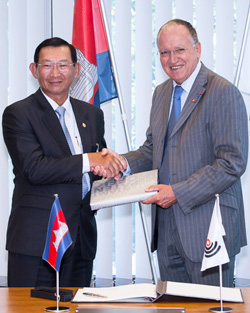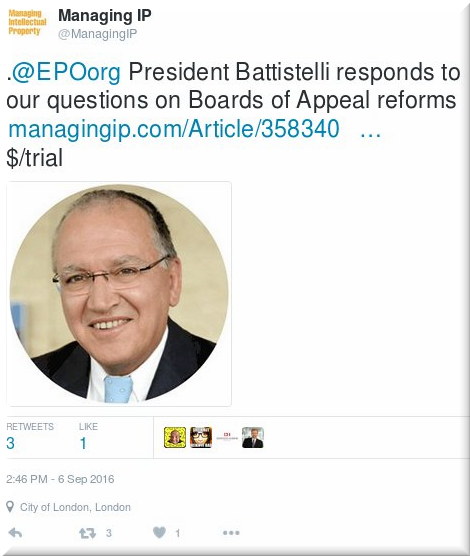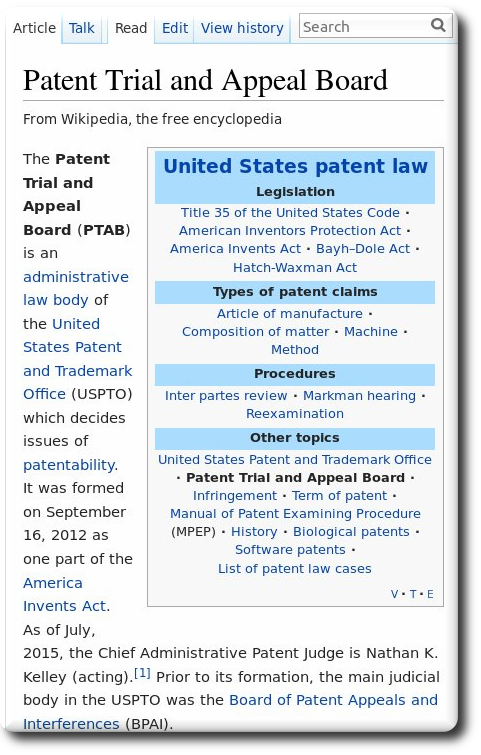09.08.16
Posted in Asia, Europe, Patents at 8:20 am by Dr. Roy Schestowitz
Maybe they can do some ‘knowledge transfer’ regarding purges

Summary: Benoît Battistelli keeps scraping the bottom of the barrel by meeting with notorious tyrants and leaders from nations which have virtually nothing to do with the EPO (no patents)
YESTERDAY the EPO reinforced our observation that Battistelli has turned the EPO into something that nobody wishes to be associated with, not even in the world of politics. The exceptions are typically tyrants or politicians from notorious countries that have virtually no European Patents (e.g. in Latin America).
“One can judge an Office and a President based on the company s/he keeps…”From the country best known for Pol Pot (studied in Paris, just like Battistelli) and French colonisation we now have this new Battistelli charade [caution: EPO can probably track clicks on this]. It’s almost as if people from respected nations don’t want to be seen with Battistelli (not anymore), so he races to the bottom for photo ops. Can someone from the EPO (or from patent agents) please check for us how many European Patents exist in the database from Cambodia? According to the EPO’s media people, “EPO President Benoît Battistelli hosted the delegation, which was led by Senior Minister Cham Prasidh, Minister of Industry and Handicraft, and also included Cambodia’s Ambassador to Germany, Thai Chun.”
We look forward to Battistelli’s IP talks with Iran, North Korea, and maybe even Libya. One can judge an Office and a President based on the company s/he keeps… █
Update: it has meanwhile come to our attention that the number of European Patents from Cambodia is 0. Yes, zero! Well done, Battistelli.
Permalink
 Send this to a friend
Send this to a friend
09.07.16
Posted in America, Courtroom, Patents at 4:57 pm by Dr. Roy Schestowitz
Those who play with fire (software patents) die in a fire

Summary: Raniere needs to pay $1.1 million (legal fees of the defendants) in a patent lawsuit which he himself initiated, only to find that his software patents are a worthless pile of papers
EARLIER this year we noted that Jericho Systems threatened a resurgence of software patents at a time of sunset for them (they’re dropping like flies these days). “Jericho could be the next Alice,” Benjamin Henrion noted, pointing at “No. 15-1502 (Eligibility of Patent No. 8,560,836 under Section 101 – Abstract Idea)” though we very much doubt it will ever reach SCOTUS as Jericho Systems might hope. In fact, this latest SCOTUS roundup from Patently-O (published earlier today) suggests there will be no more tests regarding software patents. “Three eligibility cases are pending before the Supreme Court,” says the site. “Of these, the most interesting is likely Genetic Tech v. Merial.” As we noted yesterday, there is also one case regarding the eligibility of design patents. Still, nothing that can refute/annul Alice or even the Bilski case. What does it all mean? Well, expect a lot more software patents, once properly challenged, to die in a fire.
Another death has just been reported for several software patents, demonstrating that holders of such patents oughtn’t bother with software patents (neither application nor litigation). It’s not just a waste of money but it can cause tremendous financial damage to oneself, as this latest story illustrates. Raniere basically sued two large companies and now he needs to pay them a fortune (over a million bucks for an individual, putting aside his own legal bills). In other words, rather than them being the victims it is him who is the victim of his own reckless actions. It’s him who will pay the price for suing with software patents that are not even patent-eligible. This story has been covered by WIPR (behind a time-sensitive paywall). Yesterday it said that “Microsoft and telecoms company AT&T have been granted more than $1.1 million in attorneys’ fees after succeeding in a patent suit against an inventor. Keith Raniere had claimed that the companies had infringed his software patents in February last year. The patents concerned were US numbers 6,373,936; 6,819,752; 7,215,752; 7,391,856; and 7,844,041. The order was filed at the US District Court for the Northern District of Texas, Dallas Division, on September 2.”
This case shows that holders of software patents can be (self-)bankrupted if they choose to sue using software patents post-Alice. Also behind paywalls today we found this report from Law 360. It says that “A Texas judge Friday granted Microsoft Corp. and AT&T Inc. attorneys’ fees after the companies defeated an inventor’s suit claiming infringement of his software patents, saying the man’s litigation conduct “demonstrates a pattern of obfuscation and bad faith.”
“Keith Raniere filed suit against AT&T and Microsoft in February 2015, asserting the technology giants infringed upon five patents that he owned for technology covering network conferencing systems. (Credit: AP) In her 13-page ruling, U.S. District Judge Barbara M.G. Lynn determined the cases filed by plaintiff Keith Raniere…”
This happened in Texas, so it is a major warning sign to a lot of patent trolls. “Hopefully many more judgements like this to come,” an activist against software patents told me yesterday. Another person, one who is making excuses for the rocket docket of patent trolls (Texas), said “it depends on who owns the #swpats – if owned by corporate entity better chance they will survive & flourish – #patentdeform” (always brandishing the hashtag “#patentdeform” as if cracking down on patent troll is a horrible things).
So, as expected, a major win for opponents of software patents and more excuses from their proponents, like Daniel Henry in this case (his Twitter activity suggests he’s likely part of the patent litigation industry).
Not many sites have written about this case (at least not yet*) and software patent propagandists like IAM are just shedding tears for parasites that elevate the price of phones without actually making any (patent assertion firms). Well, next week they’re running a Webinar titled “Readying a Patent Portfolio for Sale: What You Need to Know to Be Successful” (often sold to trolls or patent assertion firms) and yesterday they noted that the “Beijing-based patent buying fund Ruichuan – the closest thing that China looked to have to an SPF – has recently gone private, after Zhigu, the firm that managed it, was absorbed into the IP department at consumer tech company Xiaomi.” SPF is a Sovereign Patent Fund and it typically achieves little more than enrichment of parasitic elements like patent lawyers — the same sort of people who bemoan the demise of software patents. █
____
* They typically keep intentionally quiet when there’s bad news for them, instead cheering and shouting for weeks if not months when there’s good news for them (like Enfish). That’s the propaganda pattern of deception by omission or selective coverage.
Permalink
 Send this to a friend
Send this to a friend
09.06.16
Posted in America, Courtroom, Patents at 11:31 am by Dr. Roy Schestowitz
Turning a blind eye to the highest court in the United States is unwise

Blind leading the blind
Summary: An update regarding the sordid state of patents on software in the US, where one has to rely on examiners and/or judges ignoring the US Supreme Court in order to have these granted/upheld
Software patents have always been the primary topic here. Longtime readers can attest to that. Thankfully, after Alice (2014), no imminent resurgence of software patents is expected, at least not in the near future. Several months ago when it was predicted that the SCOTUS (US Supreme Court) would deal with low-quality design patents of Apple we noted that no SCOTUS case was bound to reconsider the patentability of software. There wasn’t even another Bilski in the pipeline.
“Thankfully, after Alice (2014), no imminent resurgence of software patents is expected, at least not in the near future.”According to this new SCOTUS preview from Patently-O, only design patents would be questioned. Nothing would change when it comes to software patents, at least not at SCOTUS. To quote Patently-O: “When the Supreme Court’s October 2016 Term begins in a few weeks, its first patent hearing will be the design patent damages case of Samsung v. Apple. In Samsung, the Court asks: Where a design patent is applied to only a component of a product, should an award of infringer’s profits be limited to those profits attributable to the component? The statute at issue – 35 U.S.C. § 289 – indicates that, someone who (without license) “applies” the patented design (or colorable imitation thereof) to an article of manufacture, “shall be liable to the owner to the extent of his total profit.” Up to now, courts have repeatedly held that the “profits” are profits associated with the product (i.e., the article of manufacture) being sold, but Samsung is asking that the profits be limited only to components of the product closely associated with the patented design. Although Apple’s position is supported by both the text and history and is the approach easiest to calculate, I expect that many on the Court will be drawn to the potential unjust outcomes of that approach. Apple wins in a 4-4 split. Oral arguments are set for October 11, 2016.”
We previously explained why design patents are similar if not overlapping software patents (the user interface angle in particular). We therefore hope that Apple will lose this case — a case which we wrote about nearly half a dozen times so far this year.
“When it comes to software patents, empirical evidence typically shows that their existence harms innovation and causes more harm than good.”“Professors Feldman and Lemley are well-known for their skepticism about the current form of the patent system,” wrote Neil Wilkof yesterday in IP Kat. It’s not a bad post and here is what it says about the seminal/cited paper: “The authors make a basic distinction between ex ante and ex post with respect to technology transfer and licensing. A significant amount of meaningful technology transfer is “ex ante”, namely it takes place before the patent issues, and sometimes even before it is filed. To the contrary, licensing demands and litigation leading to payment for freedom to operate, occurs “ex post”, after the patent is issued, sometimes long after grant. Even in the life sciences field, where one might expect more evidence that technology transfer would be taking place, the authors found that the “modal license” was primarily for payment for freedom to operate rather than technological transfer of the underlying technology.”
When it comes to software patents, empirical evidence typically shows that their existence harms innovation and causes more harm than good. “Despite Alice,” Benjamin Henrion wrote yesterday, “specialized patents courts keeps issuing software patents in the US” (known issue), but as long as the Supreme Court repudiates such nonsense we’re probably OK in the long run. Upon appeals, e.g. to CAFC (a bit pricey), software patents almost always die. Lower courts need to heed the warning and stop ignoring policies imposed (or handed down) from above.
“Suffice to say, “open source software” as the above names it (Free/libre software) is not compatible with software patents.”Dropbox, according to this page, has “4 new DROPBOX patent applications,” to quote Fresh Patents. They are pursuing software patents (the titles suggest so) on all sorts of basic Web operations. Will USPTO examiners be negligent enough to grant in spite of prior art and Alice? We shall see. One sure thing is, the courts (the higher, the better) won’t tolerate these.
We recently wrote about Blockstream making a patent pledge despite having no patents. This new report suggests that Blockchain technology faces patent-related problems. To quote IP Watch: “Blockchains, such as the well-known bitcoin, are not yet well-defined but are creating a lot of hype, speakers at a 23 August Intellectual Property Owners’ Association webinar said. Two things are clear so far, they said: the technology is in its infancy, and there are lots of unresolved questions about what is patentable and how IP laws intersect with the mostly open source software used in the systems.”
“If the Supreme Court was to be respected rather than ignored for convenience (or maximisation of profit), there would no longer be trials over software patents, let alone new grants of software patents.”Suffice to say, “open source software” as the above names it (Free/libre software) is not compatible with software patents. Neither are APIs (lesser form of “open source”), yet according to this new patent survey, there are more than 23,414 API patents. To quote D-Zone: “After looking through the 23,414 API related patents from between 2005 and present day from 4,283 companies, it is clear that the API patent game will be all about which companies decide to litigate using their “intellectual property.” There is definitely a lot of education that could occur across all industries where these patents will be put to work, and hopefully we can see some reforms at the USPTO regarding how important it is to the economy that the APIs themselves to remain open and reusable, but I think that ultimately the world of API patents will be hammered out in courts across the United States, and other countries around the world.”
Oracle now claims copyrights on APIs, in a case which involves a mixture of software patents and copyrights inherited from Sun upon acquisition. We hope that readers are able to see just how profound an impact all these efforts to apply ‘IP’ to code can have. When can developers go back to coding in peace? Well, hopefully when all courts and patent examiners pay attention to Alice and apply the corresponding test. If the Supreme Court was to be respected rather than ignored for convenience (or maximisation of profit), there would no longer be trials over software patents, let alone new grants of software patents. █
Permalink
 Send this to a friend
Send this to a friend
Posted in GNU/Linux, Microsoft, Patents at 10:47 am by Dr. Roy Schestowitz

Summary: Another glimpse at where Nokia stands after Microsoft entryism and the ugly effects of patent trolling — something which Microsoft has played a considerable role promoting as it harms Free/Open Source software (FOSS) the most
ONCE UPON a time there was a mobile giant called Nokia, before Microsoft infiltrated the management (Elop), had it turn down Linux, and later turned it into a patent parasite, as expected by us all along. Any way one looks at it, Nokia is a patent parasite and Benjamin Henrion has said, “I booked http://nokiaplanp.com [P for patents] where that was the frenzy of its future. I was right.” See the latest articles in our Wiki for a detailed blow-by-blow chronology.
“Remember that IAM is funded by a troll of Nokia, MOSAID (now called Conversant, after all the negative publicity), armed with Nokia patents after Microsoft insisted on it (this is well documented).”According to IAM, Nokia is so large a patent parasite right now that it makes literally billions by taxing companies with its old patents. “Nokia Technologies head steps down just after company joins the $1 billion licensing club,” says the headline from IAM. Remember that IAM is funded by a troll of Nokia, MOSAID (now called Conversant, after all the negative publicity), armed with Nokia patents after Microsoft insisted on it (this is well documented). Microsoft has a certain ‘skill’ when it comes to creating and/or arming patent trolls, including the world’s largest patent troll, Intellectual Ventures.
The other day we saw the article “Spotify Under Attack from Suspicious ‘Patent Troll’ Venadium LLC…” (probably not one among the thousands of satellites of Intellectual Ventures, but who knows)… [via]
We find it rather ironic, as the company which recently hired from Microsoft the patent mafioso who had armed patent trolls to attack rivals (including Linux, even after his departure) now faces the threat of an incognito patent troll. To quote this “Exclusive” report:
These companies often earn the dubious award of being known as “patent trolls,” of which Venadium may qualify within frustrated tech circles. The Eastern District of Texas is a well-known breeding ground and lawsuit haven for dubious, ‘patent troll’ type cases, with an 88% win for plaintiffs in patent infringement lawsuits, compared to a nationwide average of 68% (at least back in 2006).
The Eastern District of Texas and statistics about it put me in a long argument with the patent microcosm (they don’t like the characterisation of it as plaintiff-friendly), culminating in this citation that claims “36% win rate for plaintiffs”.
Regardless of the true numbers (can we trust lawyers more than we trust journalists?), here is a new article published very recently to explain how patent trolls operate.
How the current patent system actually hurts innovation (and how patent trolls are being fought)
[...]
One of the most common questions I get asked when talking to companies about their issues with innovation is “how do we prevent someone stealing our ideas? Should we get them all patented?”
Unfortunately, the answer to that isn’t so simple.
And that is because the current system for getting patents is in many ways no longer in line with how the world’s businesses work.
And worse than that, in many cases it is being abused by companies in ways which actually discourage innovation completely.
[...]
The issue seems to stem from the fact that the patent office just cannot check whether the people filing for a patent are in fact the original creators of the technology. For example, here is a patent granted to a person in 2002 for his description of “How to swing on a swing“.
[...]
If you want to prove that the patent was not valid, then the only way to prove that the lawsuit should not have happened in the first place is to have the legal system decide, analyse all the patents and claims, and determine once and for all whether the patent is valid.
This process can take 3+ years, and cost over $3 million.
This is much too expensive for most small companies to pay, so instead they are forced to pay the settlement claim to the patent troll.
[...]
A lot of the most innovative companies out there are making breakthroughs in the way we work, live and play using new software, whether we use it directly (a game on our phone) or to underpin their service (the vehicle prioritisation and routing within the Uber platform).
However, software is not always something that can be patented.
In some countries you can patent software (such as the USA, although this is often debated) while many other regions including most parts of Europe do not allow it.
As many software-based companies also operate on a global basis, this can make enforcement of patents extremely problematic, especially if software with different code is able to perform the same end-result.
In fact, there is a growing movement in Silicon Valley to open up patent portfolios and let anyone gain access to and build upon some of the most important software technology in the world. Echoing Henry Ford, who openly pined for the abolition of the patent system, Elon Musk has described patents as “intellectual property land mines” that inhibit progress.
That latter part speaks more specifically about software patents — a subject we shall focus on in our next post. Suffice to say, software patents are inherently incompatible with FOSS. █
Permalink
 Send this to a friend
Send this to a friend
Posted in Deception, Europe, Patents at 9:59 am by Dr. Roy Schestowitz
Time and space virtually ‘rented out’ to EPO management (another IAM-like propaganda mill in the making)

Summary: Managing IP reinforces the view or the perception that when it comes to the European Patent Office (EPO) it’s only a little better than an external PR department
THE EPO is wasting over a million Euros per year on spurious PR like pro-UPC events in another continent. There is also a lot of hogwash now that the EPO expels the independent judges or the boards they’re part of. Shortly after Battistelli was demolishing the boards and putting lipstick on the pig (see our translation of the hogwash) James Nurton is again, having done a softball ‘interview’ with Battistelli earlier this year in order to help him cover up/whitewash amid peak of a crisis (boiling point), jumping to his rescue. There is this new ‘Managing IP’ (MIP) nonsense titled “EPO President Battistelli on appeals reforms”. Why not just reprint a prepared (by the EPO’s PR team) ghostwritten piece? They frame this as an interview, but any fool can see what it really is. It’s supposedly behind a paywall (“$/trial,” as they put it in Twitter less than an hour ago), so the choir gets preferential access to the lies, the rest will find it harder to rebut (let alone see). This is a common tactic when suppressing criticism. The same goes for attendance at events where dissent is being discouraged/disallowed (e.g. by limiting who can speak and charging a furtune to attend, with exceptions/discounts to ‘desirable’ guests).
“…James Nurton is again, having done a softball ‘interview’ with Battistelli earlier this year in order to help him cover up/whitewash amid peak of a crisis (boiling point), jumping to his rescue.”What on Earth is happening to MIP? It’s even a multi-part Battistelli series, clearly prepared in advance to be released in conjunction with today’s UPC advocacy event. “This is the first of a two-part article,” Nurton wrote. “A further interview with Battistelli, on the social situation at the Office, will be published later this month.”
So, basically, they are planning to publish complete and utter lies like those we explained under an hour ago (the so-called 'social conference' and social report/study).
Shame on MIP. They’re not journalists, they’re actually Battistelli’s propagandists now. Some EPO staff is attending (not willfully) their UPC event, which they have advertised as follows: “Our #EUPatent16 forums take place this week in Munich (Tuesday) & Paris (Thursday) incl. panels on #UPC, #UnitaryPatent, #Brexit & #Frand”
This is a UPC promotion event. Make no mistake about it. Look who has speaking positions. It was mentioned here before, not just a month ago but also days ago. Hastags like #Brexit #EUPatent16 #UPC and #UnitaryPatent are being used by MIP to promote this and even #Frand (yes, the anti-FOSS, pro-software patents Trojan horse!)
“Come on,” they told me this morning. “We’re not in the business of promoting #UPC or #Unitarypatent – just providing a platform for discussion!”
“This is a UPC promotion event.”Yeah, right…
Another ‘conference’ brought to you by EPO, sort of…
“I can say very much the same,” said someone about the EPO a short while ago. “Management is loyal only to hidden agendas, power and weak moral.”
The problem is, MIP agreed to do the EPO management’s work. This shows that their integrity is flaky to say the least. They also profit from this event (over a thousand Euros for each person to attend a one-day event, assuming standard charges).
“I know you claim to have a neutral position,” I replied to them, “but the speakers’ lineup will likely omit any opponents,” as usual.
“They also profit from this event (over a thousand Euros for each person to attend a one-day event, assuming standard charges).”Well, perhaps foreseeing a backlash for licking Battistelli’s boot, MIP wrote to me this morning, hours before the puff piece and around the time the aforementioned event started.
“Disagree,” they added. “Based on our previous events, we expect a full range of views from speakers & audience. You should come to one!”
I replied with “€1095 for a one-day event about the #upc (plus plane tickets) [is] well beyond my means. Event for the rich to preach to the rich.”
“Our events are free for in-house counsel, academics & R&D professionals,” they replied. “Come next year as our guest!”
“We are very sad to see MIP becoming a lot more like IAM, which is the propaganda mill of Battistelli, still.”Well, being a guest at an event with thugs like Team Battistelli (and their bodyguards) doesn’t sound all that safe and besides, the place will be stuffed/stacked with pro-UPC people. It’s like entering the lion’s den.
We are very sad to see MIP becoming a lot more like IAM, which is the propaganda mill of Battistelli, still.
As an aside, the EPO’s PR people have been 'spamming' universities even today (this morning onwards). They don’t publicly mention or endorse MIP’s event, but it’s clear that they’re very much embedded in it. It’s not at all hard for outsiders to see. █
Permalink
 Send this to a friend
Send this to a friend
Posted in Deception, Europe, Patents at 9:08 am by Dr. Roy Schestowitz
Big lies from a chronic liar [1, 2]

Source (original): Rospatent
Summary: Battistelli is attempting to purchase (i.e. pay for, at the EPO’s expense) an alternate reality wherein EPO staff is absolutely delighted and the social climate is fantastic — all this for the purpose of evading accountability for his systematic abuses that left him with 0% approval rate (literally!), suicidal/depressed staff, and notable brain drain as well as considerable decline in the quality of work [1, 2]
EARLIER this year and last week we mentioned the so-called ‘social conference’ [1, 2, 3, 4, 5], which relates to the social study [sic] commissioned by the liar (Battistelli) and his goons, relying on gross omissions and hired propaganda mills. Battistelli, being a politician, would go as far as necessary to protect his horrible regime, even if that means lying and insulting people’s intelligence.
Next month, at a very strategic time (no coincidence there), the EPO will release Battistelli’s massive and expensive propaganda, unleashing a large bundle of lies to justify not bringing up union-busting and violations of the law in the Administrative Council’s (AC) meeting. Wait and watch. Team Battistelli will continue to shamelessly rubbish justice and try to cover it up with a large bundle of lies, as usual.
The following new comment on the subject is quite revealing:
the stated purpose of the social conference is:
- presenting the results of the occupational health and safety risk assessment (ohsra) and the social study
- forming working groups to discuss these results
- work shops (by now these two points will be done on the same day as the presentations)
- expected results of the working groups and the workshops are
-_- an analysis how the previous reforms influenced the results of the social study and the ohsra
-_- suggestions how the previous reforms need to be amended to restore social climate, of course without an impact on the results of these reforms (so continued abolishment of steps and career, lower salaries, increased work pressure, less secure pensions for newcomers, …)
Both results will be presented to the AC, together with an analysis of the administration of these results, as well as an opinion on the studies by the administration.
How can the administration coordinate the working grouos, and work on their own analysis, as well as waiting for the results and form an opinion on that all on the same day, without most of all that already pre-written?
I bet they even prepared an analysis to be presented by the staff representative groups (FFPE, and the official Staff Representation)
I also wonder how they expect Staff Representation as well as FFPE to be able to actively particiate in all areas, when they do the working groups all at the same time, and will not allow sufficient “experts” to participate; no chance to discuss among themselves, and still deliver opinions on the same day which will be seen as representative of “all staff” if favourable for management, or “dissenting opinions of disgruntled single individuals” (a.k.a. violent and vocal minority) when not in favour of previous and future management actions.
I expect this whole exercise to deliver even more pre-cooked management “Bullshit-Bingo” catchwords without content, but used as justification to push the border of our legal issues even further….
We have loads of new material regarding the EPO. A lot of it will have been published before the so-called ‘social conference’ and we expect some press coverage to that effect, scrutinising the Battistelli regime in some form ahead of the next AC meeting. Dirty laundry will help convince delegates and journalists that everything Battistelli and his yellow ‘union’ say can be disregarded. For those who forgot what FFPE stands for, here is a reminder of past articles:
- In the EPO’s Official Photo Op, “Only One of the Faces is Actually FFPE-EPO”
- Further Evidence Suggests and Shows Stronger Evidence That Team Battistelli Uses FFPE-EPO as ‘Yellow Union’ Against SUEPO
- “FFPE-EPO Was Set up About 9 Years Ago With Management Encouragement”
- Fallout of the FFPE EPO MoU With Battistelli’s Circle
- The EPO’s Media Strategy at Work: Union Feuds and Group Fracturing
- Caricature of the Day: Recognising FFPE EPO
- Union Syndicale Federale Slams FFPE-EPO for Helping Abusive EPO Management by Signing a Malicious, Divisive Document
- FFPE-EPO Says MoU With Battistelli Will “Defend Employment Conditions” (Updated)
- Their Masters’ Voice (Who Block Techrights): FFPE-EPO Openly Discourages Members From Reading Techrights
- Letter Says EPO MoU “Raises Questions About FFPE’s Credibility as a Federation of Genuine Staff Unions”
- On Day of Strike FFPE-EPO Reaffirms Status as Yellow (Fake/Management-Leaning) Union, Receives ‘Gifts’
- Needed Urgently: Information About the Secret Meeting of Board 28 and Battistelli’s Yellow Union, FFPE-EPO
- In Battistelli’s Mini Union (Minion) It Takes Less Than 10 Votes to ‘Win’ an Election
- FFPE-EPO Going Ad Hominem Against FICSA, Brings Nationality Into It
Sheer propaganda “is good enough for political operators such as BB [Battistelli],” says the following new comment:
Thanks for the explanation. It seems that we have yet another example of a classic BB strategy, namely “consultation” in the form of allowing others to speak but having no intention of listening to them (let alone taking heed of anything that is said).
Of course, this strategy has nothing to do with the dictionary (or commonly understood) definition of “consultation”, but is good enough for political operators such as BB.
Quite frankly, the whole charade is just an insult to the intelligence of the staff representatives and all neutral observers. Not that this will stop the AC swallowing the results hook, line and sinker. What a debacle!
In another thread, one regarding privacy, the EPO's privacy violations (including medical data protection) are brought up again, noting that “patent processing at the EPO is not in compliance with EU standards for data protection.”
Here is the comment in full:
A patent is worth a lot of money.
Personal data are the bibliographic data, payment method, communication with the EPO but also the application (claims/description).
It is incredible that the patent processing at the EPO is not in compliance with EU standards for data protection.
Coming up soon are more articles about data protection abuses, the race to the bottom at the EPO, union-busting activities and highly negative social atmosphere at the Office. We urge readers to relay information about those things to both journalists and delegates as Battistelli prepares to lie to them in a big way. They need to be properly informed in order to counter his claims. █
Permalink
 Send this to a friend
Send this to a friend
09.05.16
Posted in Asia, Patents at 6:53 am by Dr. Roy Schestowitz
Bad policies and inability to learn lessons from the failed experiment in the US

Hazy forecast for an increasingly greedy Asian industry (photograph/source: “Smoke from Indonesian fires hits ‘unhealthy’ levels in Singapore as authorities push to hunt offenders”)
Summary: Patent maximalism and patent hoards which include software patents cause a climate of fear and confrontation, not innovation or collective prosperity
THE ONLY region other than the US where software patents exist is east Asia, although there too there are limitations (there are no software patents in India, Europe and arguably not in Australia either, definitely not in New Zealand and South Africa).
Looking at a new article by the Intepat Team from India, they mostly explore how to get patents in other countries, notably Europe and the US. They’re trying to make money by doing in other countries what they cannot do in India because activists (not just Indians) guard against corporate lobbyists and patent lawyers. In Singapore, by contrast, software patents exist (there is also a large Indian population there) and MIP has this new article regarding Singapore, titled “Inventors, investors and software patents” (as if these three things are connected, as per the myth).
“InnovFest unBound,” MIP said, “showcased Asia’s most innovative media and healthcare technologies. Presentations from fintech companies, multi-national media and software companies and global product giants emphasised the need to protect the IP underpinning new technologies and new products.”
That’s nonsense. It’s basically software patents lobbying in thin disguise. Consider Creative of Singapore becoming a de facto patent troll because it can no longer sell actual products (or can hardly sell anything before patents expire). It’s truly embarrassing not just for Creative but also for Singapore; the company reaffirms its new status as “patent troll” in Texas with yet another lawsuit, this time targeting the British (soon Japanese) ARM and the Singaporean regime’s mouthpiece (notorious media company) wrote:
Creative Technology yesterday said its wholly owned subsidiary ZiiLabs Inc has filed a patent infringement lawsuit in the United States against tech firm ARM.
ZiiLabs owns over 80 US patents in the graphics, processor and 3D spaces.
Four of these patents were asserted in the lawsuit, in which ZiiLabs is claiming damages for patent infringement, and an injunction against ARM.
The lawsuit was filed on Sept 2 in the Eastern District of Texas.
Creative was a decent company in the 1990s (I used their hardware and their software). They ran out of business plans, they might soon go out of business, and thus they are becoming patent parasites. Is this the kind of ‘entrepreneurship’ Singapore wants to be known for? Patent trolling? And with software patents, too?
Elsewhere in the patent microcosm, IAM has a series of new articles about patents in Asia and Jack admits that “patent filings and patent ownership alone cannot give anything like a full account of an organisation’s innovative capacity.”
So why are they so often peddling this myth at IAM? Here is another new IAM article, implicitly or tacitly acknowledging that South Korea has a patent bubble which is already imploding. Similar things seem to be happening in Japan and China is sweeping up the dust. To quote IAM: “In the wake of Foxconn’s historic $3.5 billion purchase of a majority stake in Sharp, streamlining and rationalisation of the Japanese company’s extensive IP portfolio are high on the agenda for its new Taiwanese owners.”
Despite having a pile of patents, Sharp is worth only about a tenth of ARM (which is British, at least until the acquisition is complete). In China, says MIP, “Computer software accounts for about 40% of cases in the Shanghai court” (so they’re becoming more like the USPTO with low quality control and software patents). An article about China from IAM says “Zhigu and Ruichuan are now controlled by a single operating company [and it] would seem to cement the idea that they’re in a separate category from IP Bridge and Intellectual Discovery. In the absence of some kind of public deal that shows the fund licensing patents or intervening in litigation on behalf of a Chinese company that isn’t Xiaomi, it may be time to stop characterising it as a sovereign fund.”
This again emulates the kind of trolls-infested patent landscape we see in the United States. Why would Asian nations wish to shoot themselves in the foot like this? Regarding China, IAM has another article about patents as instruments of tax evasion, using the kind of loopholes we already see in Europe (e.g. patent boxes, which are tax evasion scams). IAM should know this in light of its coverage about Apple in Europe (see “Europe’s multi-billion dollar tax ruling against Apple throws treatment of IP assets into spotlight”).
The bottom line is, the way things are going in Asia are not encouraging. They fail to heed the warning of US patent chaos and troll infestation. Asia is, in a sense, becoming a powerhouse for potential patent trolls (we recently covered notable new examples of Chinese companies going to the US to sue US companies using patents, typically in plaintiff-friendly courts like those down in Texas). █
Permalink
 Send this to a friend
Send this to a friend
Posted in America, Patents at 6:15 am by Dr. Roy Schestowitz
The Patent Trial and Appeal Board (PTAB), run mostly by scientists, is a step towards the right balance

Summary: A look at recent patent news, including the expected attacks on PTAB (from the patent maximalists/microcosm) and billing fraud at the USPTO (as well as attendance abuse)
“Another big plus is letting interns apply for patents under their own name,” a puff piece about Adobe says, as if it’s a dream come true to be granted a patent.
This, to us, demonstrates a profound issue. Patents as trophies.
Take another example, this one a new article from IP Watch. To quote: “A recent patent granted by the United States Patent and Trademark Office to a Colombian company stated where the genetic resource of the invention was taken from and described the access and benefit-sharing agreement made with indigenous communities. This might be the first time that such a statement appears in a US patent, according to a source.”
“Thankfully, a solution is coming slowly, albeit not without resistance from the meta-industry which is patent law firms…”“Access And Benefit Sharing” are right there in the headline. Remember the days when the patent system (well, so we’re told!) was there to help inventors preserve/disseminate knowledge rather than sue or shake down others? Those days are long gone as a predatory meta-industry now steers public policies and wants everything patented. They’re producing virtually nothing (patent law firms), just like patent trolls. Legal papers, litigation, billing etc. are not production but burdensome bureaucracy and lawyer elitism.
How did we get here and how do we get out of this trap? How do we return to a world where it’s possible to code in peace, without fearing litigation over lines of code which were never copied/plagiarised but merely accomplish something similar to some words on hundreds of thousands of US patents on software?
Thankfully, a solution is coming slowly, albeit not without resistance from the meta-industry which is patent law firms and their large clients (companies like IBM and Microsoft; to a much lesser degree Google which actually suffers from the status quo, as we last noted last week). The patent microcosm keeps attacking PTAB and one element of this patent microcosm, IAM ‘magazine’, has just published a law firm’s sponsored “REPORT” [sic] ranting that the “Patent Trial and Appeal Board (PTAB) introduced rule changes that went into effect in May this year.” MIP, in the mean time, looks at PTAB upon its fourth anniversary. To quote its latest writing: “These included allowing patent owners to include relevant testimonial evidence with preliminary responses, clarifying that the district court claim construction standard will be used for patents that expire during a proceeding, adding a Rule-11-type certification for papers filed, and replacing page limits with word counts for briefings.”
“According to this new article from Patently-O, the USPTO has plenty to hide, including “Billing Fraud at the USPTO” (the EPO too, allegedly, has similar fraud]) and “Examiner Time and Attendance Abuses”.”MIP is now producing loaded questions that get positioned as headlines, for example “Is the Board too hard on motions to amend?”
As a reminder to readers, PTAB is the board which is responsible for getting rid of software patents faster than even courts do (as for the USPTO, it’s busy trying to maximise income by granting almost everything).
“A USPTO report,” says the above, “released in May revealed only 5% of motions to amend reviewed by the Board had been granted or granted in part – six of 118. A total of 192 motions to amend had been filed up to that point. A seventh motion to amend has since been granted, to ContentGuard in July.
“The USPTO said it released its report to “provide greater transparencies into our practices” and “aid the ongoing dialogue”.”
Well, the USPTO sure seems to be more transparent than the EPO under Battistelli, but there’s still a long way to go (see the USPTO documents we showed here last night).
According to this new article from Patently-O, the USPTO has plenty to hide, including “Billing Fraud at the USPTO” (the EPO too, allegedly, has similar fraud) and “Examiner Time and Attendance Abuses”. To quote Patently-O, a “substantial number of patent examiners are involved in “time and attendance abuse” — working unsubstantiated hours” (so much for integrity of staff).
We sure hope that more people recognise the importance of PTAB’s function. It has made enemies inside the patent microcosm because those suffering from PTAB are some of the biggest parasites out there. Unlike staff at the USPTO, PTAB staff isn’t compelled to grant if in doubt. Staff isn’t assessed by misguided Battistellite criteria.
Speaking of parasites, see this week-old article from Patently-O about the U.S. Government’s “immunity against allegations of patent infringement.” The patent system apparently isn’t applicable to everyone. Some actors are less ‘equal’ than others. In the words of Patently-O:
The U.S. Government has waived its sovereign immunity against allegations of patent infringement. However, the infringement charges are not brought via Civil Action under the infringement definition of 35 U.S.C. 271. Rather, 28 U.S.C. § 1498 spells out that the infringement claim against the U.S. must be brought in the Court of Federal Claims (CFC) and that the remedy is limited to the “reasonable and entire compensation for [the Govt’s] use and manufacture.” The CFC does not allow for a jury nor will it award injunctive relief against the U.S.
Liberty sued the U.S. alleging that the ammunition rounds manufactured for and used by the Army are covered by Liberty’s U.S. Patent No. 7,748,325. In the 1990s and 2000s, the U.S. military became concerned that lead-based ammunition might be a form of harmful pollution – the patented ammunition here follows that lead by eliminating lead from the round while remaining lethal to soft-tissue targets (such as humans). According to the patent, the projectile (shown in the image above) separates into three portions upon striking a target. The projectile also includes a reduced-size jacket that limits barrel heat build-up.
If patents are a government-enforced monopoly which the government itself is exempted from (no liability), then no wonder the perception of justice is so elusive. Unless the patent system can revert back to sanity, where promotion of science and technology (or “innovation” as today’s buzzword of choice) is paramount, people won’t be happy and they will perpetually demand change.
In a sense, by ceasing to issue software patents the USPTO would appease some of its most vocal/loudest opponents (the proponents of software patents were parasitic all along) and also paralyse most patent trolls, enabling the USPTO to repair its reputation and welcome better applications. █
Permalink
 Send this to a friend
Send this to a friend
« Previous Page — « Previous entries « Previous Page · Next Page » Next entries » — Next Page »

























 Content is available under CC-BY-SA
Content is available under CC-BY-SA